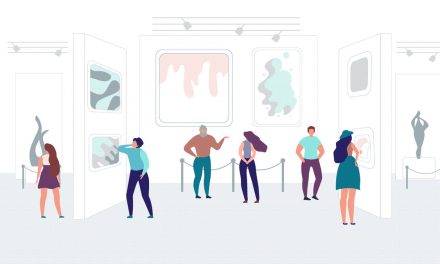
Since the financial collapse of October 2008, artists no doubt have been more challenged to sell their work than any time since the Great Depression. The recent financial collapse was a low blow to all businesses, but was particularly damaging to the business of selling art.
Unfortunately, this happened in combination with the first wave of aging boomers deciding to downsize. Many are moving into smaller dwellings, while others are ridding themselves of acquired possessions. These factors alone would bring the sales of art objects to an all-time low, but add to it the annihilation of the middle class.
This is the demographic that has carried the United States economy for the past 40 years, and with its demise comes dismal art sales, mostly because consumers have been forced to shift their spending away from art purchases to pay for basic necessities. Many “middle-class individuals” are more concerned with keeping their home or putting food on the table, paying for healthcare or funding a retirement plan. All of these priorities trump buying art for the home or personal adornment.
As if all these factors combined were not enough, throw in the news media telling the nation and millions of viewers to be frugal and not to be a conspicuous consumer. We were literally told to simplify, downsize, go Green and recycle. Don’t get me wrong, I am a big fan of taking care of the environment, but this “new frugality” has had a negative effect on our art-based businesses.
Add it all up and the picture looks bleak for selling handmade objects. Most of what we hear about artists selling their work these days is pretty negative. Yet I keep meeting and consulting with artists who are doing surprisingly well and posting increased sales, while other artists are posting business growth despite the current condition of the economy. How can it be that some are doing well while others are faltering? I have been giving this a lot of thought lately and asking artists what the secrets are for their surprising success. Here are a few of the common threads I have sewn together to help you with your own businesses:
1. Only exhibit at shows that are worthwhile There are tons of shows across the county, but they are not all created equally. Some draw a crowd that buys art and others draw a customer base that is only there to be entertained. Shows are expensive to exhibit at, not to mention the required energy output, the time away from making product and the relentless setting up and breaking down. It is the same amount of work to do a show where you lose your shirt as it is to do a show that yields positive cash flow.
2. Refine your jury submission images To get into better shows, you need an impressive product line with a theme and focus, as well as exemplary digital images that project your professionalism. It is tragic to see how poor most artists’ images are. Sadly, it is the exception rather than the norm to see images for the jury that are professional and impressive. Sending in inferior images to be juried is not the formula to get into good shows.
Designing work that has a “visual impact” and getting it professionally shot by a photographer who knows how to create great jury images can be a challenge. Good art badly photographed will always gets rejected—a huge lost opportunity for the artist. One of the first ways to create a better business is to make better work and have it photographed so it has a focus with a strong artist’s identity.
3. Make what customers want Once you get into a good show, you need to be well-armed with an inventory of sellable merchandise. By sellable merchandise I mean the kind of merchandise that customers want to buy. Too many artists are creating work that customers might admire, but do not necessarily want to own! Herein lies the key: Make art that people want to own and your sales will increase. This seems to be what separates the wheat from the chaff and is the key factor in creating a successful creative business today.
Creating work that customers want to buy is a lofty challenge for sure, but it can be done because I encounter artists who are having good sales every week. A bit of trend research can help you get to the core of what people are buying and will help you make art that is easier to sell.
Ever since the ’70s, American consumers have wanted art and objects of adornment so much that they were willing to buy just about anything we made. At the Rhinebeck Show in New York, the first American Craft Council show, customers wanted what we made so badly they would go to the show office and have us paged if we wandered away from our booth for too long! That is unlikely to happen today.
Throughout this period, many artists adopted the “belief” that they were entitled to make anything they wanted to and customers were obligated to buy it. And at the time, there were enough customers to make that paradigm work. (Of course, an artist is entitled to make anything they want or to make art for art’s sake. But if you want to sell it, you need to consider the market forces or you will end up with a huge inventory of your own work.)
4. Create functional products One of the biggest trends currently affecting successful businesses is the trend for function. Items that have a use are just plain easier to sell than items that have no apparent purpose than to be decorative. Look at your current inventory with an eye toward what in your line has a use. Then you must be able to clearly articulate to your customers the benefits and functionality of your art.
If you take a hard look at what you make and find an implied function in that work, look your customer in the eye and say, “When you hang this on your wall, I hope it brings you the peace and joy it did for me when I created it!” Or, “When you see the light sparkling from that amethyst, it will make you happy.” Or, “This sculpture will be the focal point of the living space you place it in!” All of these comments have a benefit to the customer, and that is a function. For items that have an apparent function, you need to be very clear and verbally communicate that information to customers. To say, “This is a Brie Cheese Baker,” is not enough. Instead, say, “The advantage to a Brie Cheese Baker is that it keeps the cheese contained so it doesn’t run all over, but also keeps it warm throughout cocktail hour,”—this is a benefit customers can sink their teeth into.
5. Impress your customers It is easy to find function in functional objects, but it is a much bigger challenge to find function in decorative ones. People buy art because they love it and it makes them feel good, but an underlying reason why people buy art and handmade things is to impress other people. If your art is not impressive, it will be much harder to sell.
The best way to a better business is to make impressive art and learn to talk about it so it impresses the customer. It will be easier to sell and attract more people to your booth when your art is impressive. And whenever you have customers in your booth, they draw even more customers in.
6. Learn from what works Here is a short list of the kinds of objects artists are having success with:
- Art that is large-scale
- Impressive products
- Handmade products created or sold in sets—such as nesting bowls or groupings of objects
- Calming, serene and natural art
- Art that moves or is kinetic
- Products that relate to food, dining or food preparation
- Items that are for or related to pets
- Crafts that are for or related to children or grandchildren
- Works that are simple and elegant
- Brightly colored art that incorporates jewel tones
- Functional products
Take a look at this list and see how you can incorporate some of these product types into the art you create. You, too, will see, just like the successful artists I gleaned this information from, that it will boost your sales and you will see more people in your booth and better cash flow. Make what you love, make it “on-trend” and use these tips to help you sell!






